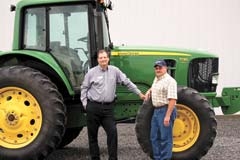How a Line of Credit Can Help Your Farm Credit Needs
“Financially Fit” is a column published by RCB Bank to help you gain knowledge on all things financial. Fitness guides – RCB Bank professionals in the field – offer ideas to help you strengthen your money sense, customize savings training, and provide qui
By: Ray McCartney | Category: Financial Services | Issue: October 2014

RCB Bank Loan Officer Ray McCartney (left) with Merl Troyer, farmer. Picture was taken at Troyer’s farm outside Pryor.
Someone recently asked me when the slow time for agriculture is. Sounds like an easy question, right? After several minutes of careful consideration, I decided that the correct answer is most definitely, “It depends.”
Some farm families say that there are no slow times. There are just busy and busier times. Those dairy cows still need to be milked and fed seven days a week. Poultry producers use most of their two-to-three week break between flocks to prepare for the next. Ranchers continue to make regular inspections on their herds, checking on herd health and new calves as well as a hundred other things.
Of the four seasons, fall may offer a bit of a break for some farmers, but it’s still a busy time for many who have soybeans to harvest, fall calves to check, and wheat and winter pastures to drill.
Fall is also a good time to visit about Farm Operating Lines of Credit (LOC), which can help farmers with seasonal or unexpected expenses. A lot of farmers and ranchers have discovered that an LOC is an effective way to bridge the gap between seasonal expenses and seasonal income.
Here’s how it works. Let’s say that a farm family no-tills 80 acres of wheat or ryegrass for pasture (a planned farm expense) every fall, but they don’t want to sell their calves (a planned farm income) until later. This creates a gap between a needed expense and the planned income. If they have a Farm Operating Line of Credit, they can advance $5,200 (plus or minus) from their already approved and processed line of credit and be ready to pay for the seed and fertilizer, and reserve the spreader. After they sell their calf crop, they pay on the line of credit.
Another popular use for a line of credit is for purchasing young calves in the spring to graze through the summer. Loan proceeds advanced from the LOC can be used to purchase the calves, medication, and feed, and will be paid back after the cattle are sold in the fall.
It’s also good to remember that interest is only paid on the outstanding balance, not the entire face amount of the loan.
A line of credit is a tool, just like a grease gun or a tractor. Used as directed, it can bridge the timing gap between an expense and the expected pay day. It requires some budgeting and planning skills to pay these loans down each year, but it can provide a credit answer to some of those farm income/expense timing issues.
If you are interested in learning more about a Farm Operating Line of Credit, call one of our friendly RCB Bank lenders, even if you’re not a current RCB Bank customer. We’ll be happy to help you discover if a LOC is a good fit for your farm credit needs.
For more savings tips and other financial articles, go to www.RCBbank.com/newsroom.
Opinions expressed above are the personal opinions of RCB Bank VP Loan Officer Ray McCartney, and meant for generic illustration purposes only. RCB Bank is an Equal Housing Lender. RCB Bank NMLS #798151. Ray McCartney MLO# 564490.
For more information, contact
RCB Bank
855-BANK-RCB
RCB Bank
For more information, contact:
RCB Bank Online:
More about RCB Bank:
More ArticlesCurrent Coupons/OffersSubscribe
For Free!
